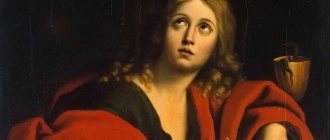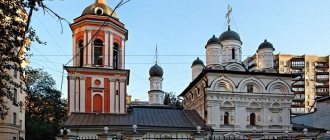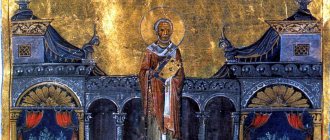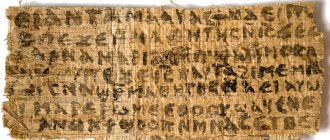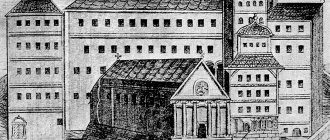Mir
Greece periphery South Aegean Islands Monastery ap. John the Theologian (Patmos) Map loading in progress...
{"format":"leaflet","minzoom":false,"maxzoom":false,"limit":50,"offset":0,"link":"all","sort":[""], "order":[],"headers":"show","mainlabel":"","intro":"","outro":"","searchlabel":"\u2026 \u0441\u043b\u0435\ u0434\u0443\u044e\u0449\u0438\u0435 \u0440\u0435\u0437\u0443\u043b\u044c\u0442\u0430\u0442\u044b","default":"","import-annotation":false,"width ":"auto","height":"350px","centre":{"text":"","title":"""link":"""lat":37.3091639000000014902980183251202106475830078125,"lon": 26.54757860000000135869413497857749462127685546875,"icon":""},"title":"","label":"","icon":"","lines":[],"polygons":[],"circles":[ ],"rectangles":[],"copycoords":false,"static":false,"zoom":8,"defzoom":14,"layers":["OpenStreetMap"],"image layers":[] ,"overlays":[],"resizable":false,"fullscreen":true,"scrollwheelzoom":true,"cluster":false,"clustermaxzoom":9,"clusterzoomonclick":true,"clustermaxradius":80, "clusterspiderfy":true,"geojson":"","clicktarget":"","showtitle":true,"hidenamespace":false,"template":"","userparam":"","activeicon": "","pagelabel":false,"ajaxcoordproperty":"","ajaxquery":"","locations":[{"text":"\u003Cb\u003E\u003Ca href=\"/palomnik/%D0% 9C%D1%83%D0%B6%D1%81%D0%BA%D0%BE%D0%B9_%D0%BC%D0%BE%D0%BD%D0%B0%D1%81%D1%82% D1%8B%D1%80%D1%8C_%D0%B0%D0%BF._%D0%98%D0%BE%D0%B0%D0%BD%D0%BD%D0%B0_%D0%91% D0%BE%D0%B3%D0%BE%D1%81%D0%BB%D0%BE%D0%B2%D0%B0_(%D0%9F%D0%B0%D1%82%D0%BC%D0 %BE%D1%81)\» title=\»\u041c\u0443\u0436\u0441\u043a\u043e\u0439 \u043c\u043e\u043d\u0430\u0441\u0442\u044b\u0440\u044c \u0430\u043 f. \u0418\u043e\u0430\u043d\u043d\u0430 \u0411\u043e\u0433\u043e\u0441\u043b\u043e\u0432\u0430 (\u041f\u0430\u0442\u043c\u043e\ u0441)\»\u003E\u041c \u0443\u0436\u0441\u043a\u043e\u0439 \u043c\u043e\u043d\u0430\u0441\u0442\u044b\u0440\u044c \u0430\u043f. \u0418\u043e\u0430\u043d\u043d\u0430 \u0411\u043e\u0433\u043e\u0441\u043b\u043e\u0432\u0430 (\u041f\u0430\u0442\u043c\u043e\ u0441)\u003C/a\u003E \u003C/b\u003E\u003Chr /\u003E\u003Ca href=\"/palomnik/%D0%A1%D0%B2%D0%BE%D0%B9%D1%81%D1%82%D0%B2%D0 %BE:%D0%90%D0%BD%D0%BD%D0%BE%D1%82%D0%B0%D1%86%D0%B8%D1%8F\» title=\»\u0421\u0432\ u043e\u0439\u0441\u0442\u0432\u043e:\u0410\u043d\u043d\u043e\u0442\u0430\u0446\u0438\u044f\u003E\u0410\u043d\u043d\u043e\u 0442\u0430\u0446\u0438 \u044f\u003C/a\u003E: »'\u041c\u043e\u043d\u0430\u0441\u0442\u044b\u0440\u044c \u0418\u043e\u0430\u043d\u043d\u0430 \u0411\ u043e\u0433\u043e\ u0441\u043b\u043e\u0432\u0430"' \u043e\u0441\u043d\u043e\u0432\u0430\u043d \u043d\u0430 \u043c\u0435\u0441\u0442\u0435 \u043 3\u0434\u0435,\u043d\u0430 \u0445\u043e\u0434\u044f\u0441\u044c \u0432 \u0441\u0441\u044b\u043b\u043a\u0435, \u043f\u0440\u043e\u043f\u043e\u0432\u043 5\u0434\u043e\u0432\u0430\ u043b \u0430\u043f\u043e\u0441\u0442\u043e\u043b \u0438 \u0433\u0434\u0435 \u043e\u043d \u043f\u043e\u043b\u0443\u0447\u0438 \u043b\u00ab\u041e\u0442\u043a\ u0440\u043e\u0432\u0435\u043d\u0438\u0435\u00bb","title":"\u041c\u0443\u0436\u0441\u043a\u043e\u0439 \u043c\u043e\u043d\u0430\u044 1\u0442\u044b \u0440\u044c \u0430\u043f. \u0418\u043e\u0430\u043d\u043d\u0430 \u0411\u043e\u0433\u043e\u0441\u043b\u043e\u0432\u0430 (\u041f\u0430\u0442\u043c\u043e\ u0441)","link": "","lat":37.3091639000000014902980183251202106475830078125,"lon":26.54757860000000135869413497857749462127685546875,"icon":""}],"image Layers":[]}
37.327198; 26.5618
Greece, peripheral South Aegean Islands, Patmos island
periphery South Aegean Islands
Greece
Monastery of St. John the Theologian
based on the place where, while in exile, the apostle preached and where he received the “Revelation”. The monastery is under the jurisdiction of the Patriarchate of Constantinople. The Greek name is Μονή Αγ Ιωάννου Θεολόγου.
History[edit]
The monastery was founded in 1088 by the Monk Christodoulos, who arrived in Patmos from the island of Kos. Permission to build the monastery was received from the Byzantine emperor Alexios I Komnenos, who on April 11, 1088 issued a golden bull to Christodoulos, which transferred the island of Patmos to the property of the monastery, exempted it from all taxes and prohibited access to the island to any government officials. Thanks to this, Patmos, according to F. Chalandon, became a small religious, almost independent republic, where only monks could live.
The hill with the ruins of the Temple of Artemis was chosen as the site for the construction of the monastery. One of the blocks of her temple was used as a throne for the monastery catholicon in the name of the Apostle John, decorated with frescoes (the earliest dated back to the 12th century). Christodoulus became the first abbot of the monastery he founded and began its construction, which lasted 19 years. The monastery was built like a fortress with bastions and towers. Around it, over the years of construction, a small village with pastures was formed, which laid the foundation for the city of Chora. The monastery was regularly subjected to pirate raids. Christodoulos left him and returned to Kos, where he died around 1111. Despite this, the monastery continued to exist; later the relics of Christodoulus, kept in the chapel named after him, were transferred to it. During its heyday, the monastery had possessions outside Patmos - in Crete, Kos, Naxos, Smyrna, and Zakynthos. In the 13th century, the island of Patmos came under the rule of the Nicaean Empire, but already the emperors Theodore II Laskaris and Michael VIII Palaiologos confirmed all the property rights of the monastery to Patmos (the chrysobul of Michael VIII was preserved in the monastery library).
After 1453, Patmos, like the other Greek islands, came under Turkish rule and paid tribute to the Turkish Sultan. During this period, the monastery continued to operate. In 1647, the monks visited Russia and presented Tsar Alexei Mikhailovich with a gift of “a wondrous and wonderful stone with the image of the Virgin Mary, which fell from the hands of an angel at the time when the Evangelist John was writing his Gospel.” This relic, together with a particle of the relics of St. Lazarus, was placed in the Annunciation Cathedral of the Moscow Kremlin. In 1770-1774, the island of Patmos was occupied by the Russian fleet under the leadership of admirals Alexei and Fyodor Orlov. The dagger of one of them is kept in the monastery museum.
How to get there?
Patmos, Greece, is a pretty secluded island. It takes effort to get there. This is probably why beach holidays there are not as developed as on the popular Greek islands. Patmos does not have its own airport, so there is only one way left - by water. You can fly into Athens (and see the sights) and from there take the ferry to Patmos. Here you need to take into account that there may not be enough seats on the ferry, so it is better to book your ticket in advance.
Patmos can also be reached from neighboring islands. For example, from the island of Kos. Catamarans depart from there daily and the journey will take a couple of hours. Transport also runs from the fertile island of Samos. There is a Flying Dolphin boat there, which will take you to your destination. The journey will take about an hour. For prices and schedules of water transport, see the website www.aegeanflyingdolphins.gr.
In addition, Patmos can be reached from the island of Rhodes. True, Rhodes is further away. You will have to sail for four hours on a catamaran. It runs every day except Monday. However, if you get seasick, such a long trip can unsettle you. But if you set out to visit this pearl of Christianity, the trials of the road will not lead you astray!
Current state[edit]
In 1999, the monastery was included in the list of UNESCO World Heritage Sites.
Currently, about 40 monks live in the monastery; services are held once a day from 3 to 6 am.
Cave of the Apocalypse[edit]
Next to the monastery there is a cave, revered as the place where the Apostle John the Theologian around 67 received his “Revelation”, recorded by his disciple Prokhor. A number of traces on its walls are associated with the apostle’s stay in it: a recess where he laid his head, a stone lectern behind which Prokhor wrote, etc. In the cave there is a church with two chapels: one is the Cave of Revelation itself, and the second is a spacious chapel in the name of the saint Anna. The cave, like the monastery, is included in the list of World Heritage Sites.
Monastery library[edit]
The monastery library has an extensive collection of handwritten and early printed books. The first of them appeared in the monastery under Abbot Christodoulos. The library inventory of the early 12th century listed 330 manuscripts (of which 267 were on parchment and 63 on paper). The library was actively replenished: already in the inventory of 1335, in addition to theological works, books on history and philosophy are indicated (works by Xenophon, Sophocles, Diodorus Siculus, Plato, etc.). The earliest manuscripts in this inventory date back to the 5th century. In the middle, a more complete catalog was compiled by John Sakkelion, who identified many works that were until then completely unknown to historians or considered lost.
Currently, the library is one of the largest Christian libraries. It houses more than a thousand handwritten books (194 of them date to the Byzantine period), 11 incunabula, about 1,200 printed books of the 16th-18th centuries and several thousand modern ones. The archives of the monastery contain unique documents on its history, starting with the Chrisovul Alexei Komnenos, who laid the foundation for the monastery.
Patmos. Cave of the Apocalypse
| Icon of the Apostle and Evangelist John the Theologian. Monastery of John the Theologian, Patmos island, Greece. |
Many of us try to put this book aside for later. While you’re young and fresh, you probably shouldn’t look into it. But when the time comes, when your hair thins and your beard turns silver, you won’t want to read any other books except this one. You've probably already guessed that I'm talking about the Apocalypse.
Patmos and Apocalypse are synonymous. Just one line in Revelation: “I, John, your brother and partner in the tribulation and in the kingdom and in the patience of Jesus Christ, was on the island called Patmos for the word of God and for the testimony of Jesus Christ” (Rev. 1:9), — decided the fate of this island forever. This is the island of the Apocalypse.
Now I myself don’t understand why I came here. Why did you plan your Greek vacation so that you would definitely end up in this cave? After all, everything here will not add even a letter to this great Book. It already has everything - and it’s not all about Patmos. It can be read anywhere and anytime. Without knowing Greek at all, without having been in this very cave.
But it all happened on Patmos. And a vague hope beckoned: what if I could understand what was written more clearly? I wanted to look at the place where everything happened. Where is the Evangelist John, the beloved disciple of Christ, who was reclining on His chest at supper - suddenly he did not recognize his Teacher who appeared to him here and fell in fear on the cold stone floor of the cave...
Patmos is a dot on the map, an island in the Aegean Sea, not the largest and not the smallest in the Dodecanese (as the Greek islands are called). But Patmos is also a whole universe, a huge spiritual magnet for all humanity. And the name of this island sounds to the believing heart in the same way as the holy and dear words of Optina Pustyn or Diveevo sound to us - apart from even the meaning.
Preparing for the trip, I re-read the Apocalypse several times and I’m still reading it - I can’t stop. This book takes you captive and never lets you go. So gradually I wanted to at least “explain” this prophetic book a little. It’s not for nothing that Elder Paisiy of Athonite wrote already in our times that today some prophecies of the Apocalypse are revealed to us simply by reading newspapers...
So I took the plunge and this is what happened. “A sword sharp on both sides” (Rev. 1:16), coming out of the mouth of Christ, perhaps means the complete power of Christ the Almighty both over earthly life and over eternal life, revealed beyond the grave...
| Monastery of the Apostle John the Theologian on the island of Patmos, Greece. |
“A great red dragon with seven heads and ten horns, and on his heads seven crowns” (Rev. 12:3). But this is Soviet power! And the seven diadems (crowns) are our old and recent general secretaries, from Lenin to Gorbachev inclusive (there were just seven of them “crowned” by the Soviet regime, but in fact, with the Trotsky-Bulganin-Malenkov family, there were ten). Everything fits! Go ahead.
An angel splashed from the bowl onto the Sun, and it began to burn people with unbearable heat... But last summer we all felt this heat! The wells in my village have dried up. The potatoes did not grow at all... People in the cities suffered from the heat, but instead of conciliar prayer they stocked up on air conditioners and cursed at the heat... Everything comes together again... You can go further and further. But I told myself: enough!
I remembered the only “interpreter of the Apocalypse” I knew (he even created a special website on the Internet), and how much he, poor thing, had become so imaginative in his desire to understand and explain everything... No, I’d rather just read this book, without claiming any interpretation. Moreover, it says that it is necessary not so much to interpret as to fulfill what is written (“Blessed is he who reads and those who hear the words of this prophecy and keep what is written in it; for the time is at hand” (Rev. 1:3).
Although one cannot help but see that many of the realities of our days - from Chernobyl and the European Union to barcodes and natural disasters - are not only predicted, but even depicted in this book. If you wish, you can see behind the images of the Apocalypse both the “events of September 11” and the strengthening of China... Although it is not entirely clear whether we are talking about these events and phenomena themselves, indicated in the Book, or only about their similarities that can be repeated more clearly in the future... But I think that times and dates have already approached so much that it makes sense to talk first of all about prophecies that have not yet been fulfilled, and not about those that have already been fulfilled before our eyes...
I got to Patmos on August 1, my 46th birthday. It just so happened that on other days the trips were canceled (and for some reason the excursion was even postponed to this very day). So, this is a gift from the Lord, I decided and hit the road. Everything, as it should be, began with a temptation - for some reason the bus to the port of Kos was forty minutes late. It also ended in temptation - in the last minutes before sailing from Patmos, my wife and daughter suddenly “dissolved” in the coastal shops. And I ran in despair along the coastline of the great island and prayed to God to “delay time” until the boat sailed... Isn’t this an illustration of a small “apocalypse”? In the last minutes, the wife and daughter appeared at the pier as if nothing had happened. It turned out that they simply bought two jars of Greek olives, not at all understanding what was happening to me at those moments. Now I believe that this is a sure sign of a successful pilgrimage - temptation along the way.
...But near the port I managed to take a characteristic shot. I saw an unusual sign on a roadside post: “Apocalypse - 2.2 km.” As it turns out, it’s already close!
Actually, writing about Patmos is a strange task. The meaning of this island is to lead people to read the Book written on it (I’m not talking about understanding - this is hardly given to anyone in full). That's why there's such a buzz around Patmos. Ships from all over the world bring tourists here. Whomever you see in this Cave of Revelation. In several languages - including Russian - monks and guides talk about what once happened here. And people listen... At least outwardly like this, at least momentarily touch the Secret. So that later it will germinate in the soul and perhaps bear fruit... To become interested in this Book. This is the mission of Patmos.
Patmos is not far from Russia at all. Not spiritually far. In the monastery Church of St. John the Theologian, in the iconostasis there are icons of the Savior and the Mother of God, sent from Russia. They were presented to the monastery by the Russian Empress Catherine II. In the museum of the Monastery of St. John the Theologian they show a letter from Peter the Great, who granted the Patmos monks important privileges in Russia - the right to visit the Empire “visa-free”, collect donations for the monastery... And the dirk of Admiral Count Orlov-Chesmensky, by unknown means, ended up on the island in this monastery museum, - a symbol of the fact that it is the Russian fleet that, if necessary, will come to the aid of the monastery. These are visible threads. And how many are invisible, invisible?
| Cave of the Apocalypse, o. Patmos. Here the Apostle John received Revelation. |
A few days before my trip, the head teacher of Samara Orthodox School No. 54, Tamara Pavlovna Samsonova, returned from a pilgrimage to Altai. She told me (she knew where I was going to go) that it was possible to go to Patmos not to Greece at all. We also have the island of Patmos in the Altai Mountains - and she just visited it. There, somewhere in the mountains, near a lake, there is a monastery in honor of the Apostle John the Theologian and a bridge to the island, which was named Patmos. Truly, it’s not Greece, but Russia that has everything... They even have their own Patmos. Just like New Jerusalem in the Moscow region. And New Athos in Abkhazia.
Why do they talk and write so much about Nostradamus, the French predictor of the 16th century? Oddly enough, there is almost no mysticism there. There is no philosophy of history, almost no spiritual meaning. There is only a dotted line of future events (besides, anything can be put under this dotted line in hindsight). It talks about three antichrists who will shake humanity. The first two already existed (Napoleon and Hitler). The third, the most terrible, is yet to come. But this generally clear meaning is clouded by many unnecessary details. Here is a typical example of his “prophetic style.”
Such a great famine from the plague wave,
From long rain over the North Pole.
Samarobren 100 leagues from the hemisphere
They will live without law, freed from politics
(quatrain VI-5).
If the first two lines are attributed by Nostradamic researchers to Chernobyl, although without evidence, then the third line - what is it about? “In the French language there is no such word Samarobren,” writes A. Penzensky (“Nostradamus and His Prophecies”), “but there is a Latin word samara - winged seed and brin - shoot, blade of grass. This means we are on the right track. Something light, delicate, winged, maybe it’s the Space Shuttle? Did Nostradamus see a picture of space exploration in the 20th century? - the modern researcher thoughtfully suggests. But you can add something more tangible to his speculations. After all, Samara became the center of the Russian space industry in the second half of the last century. And wasn’t this what the fortune teller wrote about in his encrypted language (“samarobren”)?
So in Nostradamus, if you dig hard enough, you can even find something about Samara, about the fact that the space industry will develop there. Personally, I’m somehow not very ready to believe such vague “prophecies.” Although I have no doubt that Nostradamus had a prophetic gift (prediction with an accuracy of weeks, for example, the rise to the heights of power of our most famous political figure - July 1999 - speaks for itself, and there are other amazing examples). Despite the astrological insanity, largely due to time, and also partly incomprehensible to us due to our distance from the “sources of life” - after all, the sky and its luminaries were created for signs (See Gen. 1, 14) - I have no doubt that , that Nostradamus’s views on history are still fundamentally Christian. But his prophecies are purely eventful. And the closer to France what is happening in the world, the more accurate and detailed his predictions are... He surprises, but does not explain. He predicts, but does not correct. The meaning of his prophecies is to show that all world events occur under God's leadership. And also to prepare the French (and other Europeans at the same time) for the fact that future times will not be sweet. And bloody revolutions and world wars await people... This is a prophecy about the world, but not about the Church. And that is why the world accepted them so easily, with such satisfaction and extolled them. Although, of course, one can marvel at his farsightedness, which cannot be achieved without help from Above. But the predictions of Michel Nostradamus cannot teach anything. This is an interlinear commentary on the Apocalypse, which has no independent value without the initial Book.
| Editor of the Orthodox newspaper "Blagovest" Anton Zhogolev on the island of Patmos. |
Hieromonk Seraphim (Rose) said: “It’s already later than it seems.” Director Andrei Tarkovsky, at a conference dedicated to the Revelation of John the Theologian, admitted: “The Apocalypse has already begun.” The wisest of our contemporaries, Schemamonk Paisiy of Athos, wrote: “Behind the “perfect system of credit cards”, behind computer security lies a worldwide dictatorship, lies the yoke of the Antichrist.” “Isn’t it possible to postpone the End of the World to August in order to appear at the Judgment tanned and rested! ? — the announcer of one of the Samara radio channels recently mocked the usual topic of “the end of the world.” Now the topic of the end of times has long been reliably turned into some kind of farce and joke. I don’t remember when this obscene pandemonium began. The “white brotherhood” sect set specific deadlines. Then some other fanatics either named or canceled the dates for the end of times. And the media hooted and warmed it up. And this, unfortunately, was done quite deliberately. So that there would not even be the opportunity to openly and honestly discuss this topic of the end of times seriously. Arbitrary dates are named, prophecies of some savage cannibals are dumped into the media, the menacing apocalyptic phenomena of recent years are ridiculed... As long as the images of Revelation do not disturb modern, relaxed humanity. If only people don’t look around and realize that the earth has long since gone bankrupt because of us. And soon we will all have to pay bills.
But they don’t listen to them, they listen to jokes about tanning at the Last Judgment. They name new dates and then cancel them with laughter. (I'm afraid that soon we will all no longer have time to laugh). Now a new show is on the agenda - “2012”. The corresponding film has already been shot. The roles have already been written. Someone really needs to create a kind of carnival out of the Apocalypse. Meanwhile, the “mystery of lawlessness” not only works - it, in general, has ceased to be a secret. Everything is done openly, quickly and brazenly. Biometric documents (just a step away from a microchip under the skin), plastic cards, the world's super money of the European Union and so on, so forth... By 2012, of course, we have not yet managed, but in the coming years we will read these lines of Revelation in a new way: “And he will do this that everyone, small and great, rich and poor, free and slave, will receive a mark on their right hand or on their foreheads, and that no one will be able to buy or sell except the one who has this mark, or the name of the beast or the number of his name" (Rev. 13, 16,17).
Why was the Revelation given in the Cave? After all, there are so many beautiful places on it, from which an excellent panorama opens. This is where there is scope for seeing “all the kingdoms of the world” in a unit of time! But no, Christ appeared to the Seer in the cave. This probably has some connection with the fact that the beginning of the New Era - the Nativity of Christ - also happened in a cave. The beginning of the history of Christianity and the story about the very end of human history are given in the same conditions, underground... Probably, this is also a sign that Revelation from Above can only be received by renouncing all worldly charms and beauties. Spiritual vision begins where carnal, earthly vision ends.
I am writing these lines in a nice, starred hotel on the seashore. In such places, everything is thought out so that relaxed humanity is in harmony with its fallen nature. Instead of monasteries there are hotels with many “stars”. Instead of shrines there are beaches and swimming pools. Instead of fasting, there is the notorious “all-inclusive” with bracelets that provide very short-term “bliss” for a week or two (a parody of heavenly pleasures, no less). What a smile the devil has on people! Once upon a time, monasteries attracted people. There they looked for rest and solutions to their internal problems. Now they are going “overseas” to star hotels. They lie down on the beaches and overeat in restaurants. And they wander into neighboring monasteries in short bursts, for an hour or two, and then return back to their cozy, lived-in hotels. The “abodes” for relaxed humanity are packed to capacity. It's such a time outside. And that’s why many people need just such a vacation. And I, I want to note, am not an exception at all... And therefore I am far from the thought of condemning anyone. It’s good that places of rest and places of pilgrimage often coexist, and one still cannot do without the other.
But in even world-famous Greek monasteries there are only a few monks. On Nisyros, in the monastery of Panagia Spiliani, there is only one monk, who is also the abbot. On Patmos, this universal center of Orthodoxy, where a century and a half ago there were one hundred and fifty monks, there are now only fifteen monks (although they are all randomly selected).
But people go and go into this Cave. The guides explain to them in several languages that right here the Spirit broke through a stone in the cave (in its composition this stone is threefold, as a symbol of the Holy Trinity). Many pilgrims to that opening in the Cave, which was formed during the Revelation to John the Theologian. Here . Here he rested, leaning in exhaustion with his back against the wall of the cave. And here his student Prokhor wrote down the visions that unfolded to him... This optional, in general, detailing somehow brings that great phenomenon closer to us. Connects us with him.
And everywhere on the island you see the beginning of Revelation. This icon is the first to greet pilgrims in the cave. When, among the seven lamps and together with the seven Angels, the Lord Jesus Christ Himself appeared to John - “Alpha and Omega, the First and the Last”... But he did not appear as John knew Him. How I saw Him during the calling to “catch men” (see Luke 5:10) on the Sea of Galilee, how I saw Him on the Cross... Not even the way Mary Magdalene saw Him risen, who at first mistook Him for a gardener.
The “too human” features were gone from His appearance. “Do not touch Me,” the Risen Christ mysteriously said to Mary of Magdala. “For I have not yet ascended to My Father” (John 20:17). And now John sees Him having already come from the Father. And falls to the ground in silent horror. Until He Himself raises it to reveal the secrets of the past and future.
The church community has not yet truly comprehended this strange phenomenon of the turn of the century - disputes about the Taxpayer Identification Number (TIN). Someone will see this abbreviation and immediately grimace: well, that’s what we thought!.. Now everything will be reduced to sixes... But I, as an active participant in these events that are not so far from us, will say this. Those disputes, those passions were not random and superficial. This was not an outburst of dense superstition (although, of course, there was plenty of superstition there - on both sides). And the dispute was not about sixes only, but about much more. A choice arose: whether to follow “this world” along the wide road of the Apocalypse (where it will ultimately lead - there is no need to explain) or to make an attempt to stop on this path. And stop everyone's movement towards the end. Stand as a wall in the way of disastrous “progress.” Failed. And, apparently, it won’t be possible. Now, when the technical basis for the accession of the Antichrist has already been prepared, and people for the most part are ready for anything, because they simply do not know or do not want to know the meaning of the processes taking place - it’s a small matter. Break the will of specific people. But this will not be easy to do.
And back on Patmos I tried to imagine the Antichrist. But no longer as a legendary character from the “past” (Napoleon is not an anagram of “Appollyon” from the Apocalypse?). But as a real person, as a politician of our time. Public figure and “humanist”. What will it be like? One day I dreamed about him; under strange circumstances, before the operation - then I saw him as young, twenty years old, in rather medieval settings, a kind of “prince” in whom the centuries-old Old Testament aspirations of those who once rejected Christ were concentrated. Then, in 1998, in that old dream, he was just beginning to leave through the wide open gates of the castle - into the world, to people... But that was a long time ago, I remember the dream vaguely... And now I was vainly shuffling various media images in my mind today. And there was always something missing, some touch. Well, is this guy (a media image of the imposing French Nicolas pops up) suitable for such a sinister role? No, of course not, although according to some criteria it seems to fit. And this one? It’s also not the same... And this one... Everyone doesn’t “get into character” a little. But then the outlines of the half-forgotten “NATO intellectual” Javier suddenly surfaced. The most charming of those who led and justified the destruction of Serbia. Who tried to “whitewash” the barbaric bombing of Orthodox cities. You can’t deny him his intelligence, his natural charm, or his intellect. Not even in aristocracy. Is this even a little bit consistent? It’s so charming to talk about bloody and not at all charming events... He’s probably the closest of all, because he can really be liked. Naturally, I don’t even think about any specific Javier as a candidate for the Antichrist. We are just talking about the type, about “casting” for this role. No more. For some reason, it was Javier who came to mind on Patmos. I don’t know how right I’ll be. But there probably won’t be anything brutal in appearance about the Antichrist. A demagogue and a democrat, although at the same time an aristocrat. “The most humane person” (remember him?!) with good manners and broad views. By the way, recently some famous rabbi stated that the “Messiah” will not be a miracle worker at all, but only a political leader of a united humanity.
Something that hasn’t been seen on Javier’s TV screens for a long time. It seems that our Primakov said about him then: “He is a very charming person. But I’m not inclined to transfer his charm to the organization he heads” (he headed NATO at the time). Wise words from a wise man.
Despite all the mystery of this Book, many expressions from the Apocalypse have become commonplace. They live with us and influence us. Like separate leaves, they tore themselves away from the lush tree, tore themselves away from the tree of Revelation and began to live their own separate life. “Those whom I love, I rebuke and punish” (Rev. 3:19), “Oh, that you were cold or hot! But because you are lukewarm, and neither hot nor cold, I will spew you out of my mouth” (Rev. 3:15, 16) “Behold, I stand at the door and knock...” (Rev. 3:20), “The Depths of Satan “(Rev. 2:24), “You have left your first love”... (Rev. 2:4) But we don’t even notice that all this is from that very Book!
| Road sign on Patmos: Apocalypse is 2.2 km away. Very close!.. |
John the Theologian was on this island in exile - only a year and a half or about three years (researchers have different opinions on this). But still relatively little. And yet, Patmos became his island forever. After all, he performed one of his greatest deeds on it. He left us a Book that, starting here on earth, leads to Heaven. Now everything here reminds us of the Apostle of Love, John! How important it is to visit a saint! And how good it is that there are places on earth where the prayer of a saint and his presence are especially noticeable. Anyone who has been to Diveevo has probably more than once caught himself feeling that here he was visiting Father Seraphim (I remember how in the monastery hotel the nun looked at me in amazement - when, during the “bureaucratic” interrogation upon arrival, it suddenly became clear that It’s my birthday on the day of remembrance of St. Seraphim!). Isn’t that why the Monk Ambrose created the Shamordino Monastery, so that we could visit the great Optina Elder there? And this island, all of it, became for me a place where John the Theologian himself lovingly receives pilgrims.
The Monastery of St. John the Theologian on Patmos was founded in the eleventh century by the works of the Monk Christodoulus by decree of the Byzantine Emperor Alexios Komnenos. The Emperor presented the monastery with an icon of John the Theologian, which still greets all pilgrims at the entrance to the monastery church. By the way, the temple is unusual - it was built on the site of a pagan temple in honor of the “goddess” Artemis. The columns in it are still the same, artemidines... The monastery has collected countless Christian relics. Here is kept the honest head of the Apostle Thomas, the relics of Antipas of Pergamon, who in Revelation is called the “faithful witness.” The chains of John the Evangelist are also here. Only now all this is hidden from the eyes of tourists. There are too many of them here, tourists, and they are all too different, not only in language, but also in faith. And the Greeks jealously guard their shrines from “outsiders.”
Once upon a time this monastery was an impregnable stronghold for the entire island. Behind its high walls, the people of Patmos escaped from the enemy more than once. This monastery was stormed more than once, but was never captured. Even the Turkish Sultan preferred to impose tribute on the monastery, but not test the strength of its walls. They paid off, this happened, but they never opened their gates to the enemy. John the Theologian protects his monastery!
To this day, houses near the monastery are incredibly expensive. 4-5 million euros! They are bought by the richest people in Greece. They don’t always live in them, but even having a house near such a great monastery is considered a sign of God’s favor. It is not for nothing that for so many centuries these holy walls have granted protection to the entire island.
They still left something in the monastery museum for tourists. The icon of Christ - “Behold, man!..” - by the legendary El Greco... With a touch of Italian brushwork, but still leaves a strong impression. Wonderful portrait. His face on the icon is so detailed, every detail in it is so detailed that one gets the feeling that the Archangel himself appeared and posed for the icon painter... In his right hand is a spear, which... The powerlessness of evil before the power of Archangel Michael, and therefore before the omnipotence of God, is very clearly reflected here on the icon. The Apocalypse contains not only predictions of the future, but also “predictions of the past” that are no less important for us, and one of them, the most striking, is about the Archangel Michael. “And there was war in heaven: Michael and his angels fought against the dragon, and the dragon and his angels fought against them, but they did not stand, and there was no longer room for them in heaven” (Rev. 12: 7, 8). And here - like an illustration to this line of the Apocalypse!
Now, when I hear frequent conversations about how “the demon is strong” and the like, this spectacle on the icon will always pop up: the Archangel seemed to skewer a small demon on his spear... Yes, demons are strong and powerful, but only in comparison with us . But they are powerless before God’s army.
In the tourist bustle you forget about the main thing. About why I came to this island. You learn a lot of things that are not very necessary, random. You see a lot of interesting things, but not obligatory ones. But something completely different is needed. You must, without paying attention to anyone, try to pray, no matter what. Pray! This is not easy to do amidst the flurry of people, among photo flashes and multilingual crowds. But without this, everything loses its meaning. Try to disconnect from your surroundings and lift up your heart to the One who gave His Revelation to people here. I was “covered” not in the Cave, but in the Monastery of St. John the Theologian. Under the dome of the temple, where. The temple was already closed from tourists, and the elderly monk began sweeping the floor. But for some reason he didn’t bother to send me away. Apparently, I saw a pilgrim, not a tourist. Only there did I feel the blessed closeness of all those events. They pulled me onto the bus (this eternal game of being late somewhere!), they grabbed me by the arms and wanted to take me to other halls. But I resisted. And on the island of Patmos he prayed to the One who is close from everywhere. So, it was not in vain that I went to this island. Even if, just as before, I still don’t understand much in that Book. Even though, just like everyone else, I don’t know the times or the deadlines. Let him still be full of vain and vain hopes for a “better future.” But God still heard my Patmos prayer. I still managed to break through to Him. And that means my Greek vacation was not in vain. And then whatever happens. With me, with this island. With all of us.
Anton Zhogolev o. Patmos - o. Kos, Greece - Samara. Photo by the author.
Shrines[edit]
- chains up. John the Evangelist
- part of the chapter ap. from 70th Philip
- part of the chapter ap. Thomas
- head of schmch. Antipas of Pergamon
- the power of St. Christodoulus of Nicaea
- the power of St. Macarius of Patmos
- the power of the martyr. Pachomius of Russia
- 3 crosses with particles of the Honest Tree
- particle of the relics of the immortal Cosmas
- particle of the relics of the Great Martyr. Theodore Stratelates,
- particle of the relics of the Great Martyr. Panteleimon
- particle of the relics of the Great Martyr. Jacob Persyanin
- particle of the relics of the martyr. Stefan Novy
- shoes prp. Christodoula

